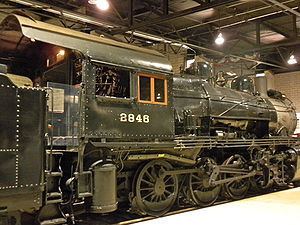Power type Steam Configuration 2-8-0 Year built 1905 Nearest city Strasburg | Number rebuilt 699 to H6sa/H6sb Area 400 m² Added to NRHP 17 December 1979 | |
 | ||
Builder PRR Altoona Works, Baldwin Locomotive Works, Alco -P Build date H6: 1899-1901
H6a: 1901-1905
H6b: 1905–1913 Total produced H6: 189
H6a: 1,242
H6b: 603
Total: 2,034 | ||
The Pennsylvania Railroad's class H6, H6a, and H6b steam locomotives were of the 2-8-0 "Consolidation" freight type, the most numerous class on the railroad with 2032 units. The three sub-classes differed as follows:
In the 1920s, 699 H6a and H6b had superheaters added and cylinder size increased from 22” to 23” and reclassified to H6sa and H6sb.
Class H6 were used throughout the system as mainline freight haulers, on local freights, and as switchers in yards. They were frequently seen double and triple heading long freight trains up the steep grades on the Pennsy.
During the period when the PRR was building the H-6 class, the railroad had effective stock control of the B&O, and installed a cooperative president Leonor Loree. The B&O acquired from American Locomotive Co. a large group of identical locomotives, originally classed I-4, but later classified as B&O class E-24. The E-24 class had many variations, some being converted to switchers, superheated, and new valve chests. The E-24a was equivalent to the PRR H-6sb. None the B&O the E-24 class survived to the Diesel era.
Survivors
PRR #2846, an H6sb built in 1905 by the Baldwin Locomotive Works, has been preserved by the Railroad Museum of Pennsylvania with two other examples of the H class. #2846 was added to the National Register of Historic Places in 1979 as Consolidation Freight Locomotive No. 2846.
